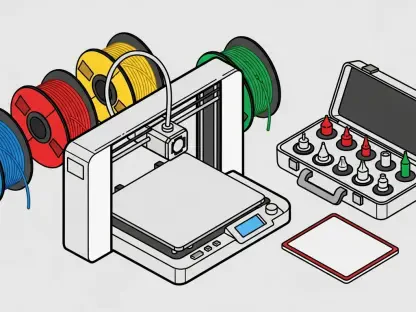Imagine a world where vehicles drive themselves with flawless precision, medical devices predict life-threatening conditions before symptoms appear, and industrial systems optimize output without human intervention. This is no longer a distant vision but a reality shaped by the integration of artificial intelligence (AI) into embedded software. As of 2025, this transformative technology is revolutionizing industries like automotive, healthcare, and manufacturing, enabling smarter and more autonomous systems. The rapid adoption of AI in embedded environments signals a paradigm shift, promising unprecedented efficiency while posing complex challenges. This review delves into the core features, emerging trends, real-world applications, and future potential of AI-driven embedded software, offering a detailed perspective on its impact across the technological landscape.
Understanding AI in Embedded Software
Embedded software serves as the backbone of countless devices and systems, from car engines to wearable health monitors, ensuring seamless operation in constrained environments. Traditionally, these systems relied on predefined logic, but the infusion of AI has introduced dynamic capabilities like machine learning and generative models. This shift emerged from a growing need for devices to adapt, learn, and make decisions in real time, responding to complex and unpredictable scenarios.
The significance of AI in embedded software lies in its ability to transform static systems into intelligent entities. By leveraging algorithms that analyze data and predict outcomes, these systems enhance operational efficiency and drive innovation across sectors. For instance, AI enables predictive maintenance in industrial equipment, reducing downtime and costs. As this technology continues to evolve, it is redefining benchmarks for performance and autonomy in critical applications.
This integration, however, is not merely a technical upgrade but a fundamental change in how industries approach problem-solving. AI empowers embedded systems to handle tasks that once required human oversight, paving the way for groundbreaking advancements. The broader technological landscape now hinges on this synergy, positioning AI-driven embedded software as a cornerstone of modern progress.
Core Features and Technologies Driving AI in Embedded Systems
AI Assistants and Open-Source Models
AI assistants have become indispensable tools for developers working on embedded software, automating repetitive tasks and boosting productivity. With a staggering 89% usage rate among professionals, these assistants streamline coding, debugging, and testing processes. Their ability to provide real-time suggestions and optimize workflows has significantly shortened development cycles, allowing teams to focus on innovation rather than routine challenges.
Open-source AI models further amplify this impact by offering accessible, customizable solutions for embedded applications. Nearly 96% of developers integrate these models into their projects, leveraging community-driven advancements to build sophisticated systems. This widespread adoption reflects a shift toward collaborative development, where shared resources accelerate the deployment of intelligent features in constrained environments.
The performance implications of these tools are profound, as they enable rapid prototyping and iteration. By reducing manual effort, AI assistants and open-source frameworks help developers tackle complex problems with greater agility. This trend underscores a growing reliance on AI to maintain competitive edges in fast-paced industries, setting new standards for efficiency and scalability.
Software Bills of Materials (SBOMs) for Supply Chain Clarity
Supply chain transparency has emerged as a critical concern in embedded software development, with Software Bills of Materials (SBOMs) playing a pivotal role. These detailed inventories catalog software components and dependencies, providing essential visibility for risk management. Currently, 71% of organizations produce SBOMs, driven primarily by demands from customers and partners rather than regulatory requirements.
The importance of SBOMs lies in their ability to identify vulnerabilities within software ecosystems, particularly in open-source components that dominate embedded projects. By mapping out every element, organizations can trace potential security flaws and ensure compliance with industry expectations. This transparency fosters trust among stakeholders, as it demonstrates a commitment to safeguarding critical systems.
Adoption of SBOMs also reflects a broader movement toward accountability in software supply chains. As cyber threats grow more sophisticated, having a clear understanding of software composition becomes non-negotiable. This practice not only mitigates risks but also enhances collaboration across teams, ensuring that security remains a shared priority throughout development lifecycles.
Emerging Patterns in AI-Embedded Software
Recent advancements in embedded software highlight a pivot to safer and more secure programming practices. Memory-safe languages like Python have gained traction, surpassing traditional options in specific embedded contexts due to their inherent safety features. This transition addresses long-standing issues of memory-related vulnerabilities, offering developers a more robust foundation for building AI-driven systems.
Another notable trend is the adoption of a “shift everywhere” security approach, which extends risk management across the entire software development life cycle (SDLC). Unlike earlier models that focused solely on early-stage detection, this strategy emphasizes continuous monitoring and post-deployment updates. Such a holistic perspective ensures that vulnerabilities introduced at any point are swiftly identified and addressed.
Concerns over governance and security risks tied to AI are also on the rise, with issues like Shadow AI—unapproved tool usage—and prompt manipulation posing significant threats. These vulnerabilities underscore the fragility of AI systems when not properly managed. As a result, there is a pressing need for dynamic frameworks that can adapt to evolving risks while maintaining innovation momentum.
Real-World Impact and Applications
AI-driven embedded software is making tangible differences across diverse industries, starting with automotive systems where it powers autonomous vehicles. By enabling real-time decision-making, AI algorithms process sensor data to navigate complex environments, enhancing safety and efficiency. This technology is rapidly becoming a standard in modern transportation, redefining mobility.
In healthcare, embedded AI transforms medical devices by facilitating advanced diagnostics and personalized treatment plans. Wearable monitors equipped with machine learning can detect anomalies in vital signs, alerting professionals to potential issues before they escalate. Such applications not only improve patient outcomes but also reduce the burden on healthcare systems through proactive intervention.
Industrial automation benefits equally, as AI optimizes machinery performance and predicts maintenance needs in embedded systems. Generative AI also finds unique applications in customer support and coding workflows, assisting developers and end-users alike. These implementations demonstrate the versatility of AI in addressing sector-specific challenges, cementing its role as a catalyst for operational excellence.
Challenges Hindering AI Integration in Embedded Systems
Technical hurdles remain a significant barrier to the seamless adoption of AI in embedded software. Vulnerabilities such as Shadow AI, where developers use unapproved tools, expose systems to unmitigated risks. Compounding this issue, 21% of surveyed professionals express uncertainty about preventing such problems, pointing to inadequate governance structures as a root cause.
Market and organizational challenges add another layer of complexity, particularly the perception gap between executives and developers. While 86% of executives consider projects successful, only 56% of developers agree, revealing a disconnect in understanding risks and outcomes. This misalignment can hinder strategic decision-making, delaying the resolution of critical issues in development processes.
Efforts to address these obstacles are underway, with dynamic governance frameworks gaining traction to adapt to AI-specific risks. Enhancing supply chain transparency through SBOMs also helps mitigate vulnerabilities by providing clearer insights into software components. Despite these initiatives, balancing innovation with robust security remains a persistent struggle for many organizations.
Future Horizons for AI in Embedded Software
Looking ahead, the trajectory of AI in embedded systems points toward groundbreaking developments, particularly with agentic AI that could enable even greater autonomy. Enhanced security protocols are expected to evolve, addressing current vulnerabilities and safeguarding against sophisticated threats. These advancements promise to push the boundaries of what embedded systems can achieve.
Long-term trends suggest that mandatory vetting of open-source components and continuous monitoring will become industry norms, elevating safety standards. Such practices could redefine how organizations approach software integrity, ensuring that risks are managed proactively. The emphasis on transparency is likely to shape policies and practices for years to come.
Evolving governance models and targeted training programs are also poised to tackle resource constraints and skills gaps. By equipping teams with the tools and knowledge needed to navigate AI complexities, these initiatives could bridge confidence gaps and foster resilience. The future of this technology hinges on a collaborative effort to align innovation with accountability, setting a sustainable path forward.
Final Reflections
Reflecting on this exploration, it is evident that AI-driven embedded software has carved a transformative niche across industries, redefining efficiency and autonomy. Its core features, from AI assistants to SBOMs, have demonstrated remarkable potential to streamline development and enhance transparency. Yet, the journey is not without hurdles, as security risks and perception gaps challenge widespread adoption.
Looking back, the real-world applications in automotive, healthcare, and industrial automation stand out as proof of the technology’s impact. Despite these achievements, vulnerabilities like Shadow AI underscore the urgent need for robust governance. The path forward demands a concerted focus on actionable solutions to address these gaps.
Moving into the next phase, organizations need to prioritize dynamic security frameworks and invest in specialized training to empower teams. Strengthening supply chain clarity through standardized SBOM practices is essential to build trust and resilience. By fostering cross-functional collaboration and aligning stakeholder perspectives, the industry can navigate the evolving landscape of AI in embedded systems with confidence and purpose.









